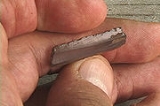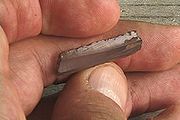
Prismatic blade
Encyclopedia
In archaeology
, a prismatic blade is a long, narrow, specialized lithic flake
with parallel margins. Prismatic blades are removed from polyhedral blade core
s through pressure reduction. This process results in a very standardized finished tool and waste assemblage
. While the prismatic blade industry is most often associated with obsidian
(especially in Pre-Columbian
Mesoamerica
), it is not limited to that material; chert
, flint
, and chalcedony
blades are not uncommon.
 Prismatic blades are often trapezoid
Prismatic blades are often trapezoid
al in cross section (see image), but very close in appearance to an isosceles trapezoid
. Triangular blades (in cross-section) are also common. The ventral surface of the prismatic blade is very smooth, sometimes bearing slight rippling reflecting the direction of applied force and a very small bulb of applied force
(indicative of pressure reduction). Flake scars are absent on the ventral surface of these blades, though eraillure flakes
are sometimes present on the bulb . The dorsal surface, on the other hand, exhibits scar ridges running parallel to the long axis of the blade. These facets are created by the previous removal of blades from the core. The proximal end contains the blade's striking platform
and its bulb of applied force, while the distal end will consist of a snap break, a feather termination, or a stepped termination.
s from the Preclassic period
on until the arrival of the Spanish
in the early 16th century. Ethnohistoric sources recount the process of prismatic blade production. Fray Motolinia
, a Spanish
observer, recorded:
The production of prismatic blades creates not only a very standardized final product, but also a standardized waste assemblage. The analysis of obsidian debitage
can reveal whether or not prismatic blade production occurred at a site and, if it had, what stages of production the process included. In other words, the types of manufacturing waste present (e.g., rejuvenation flakes and/or blades, platform rejuvenation flakes, etc.) at a site can inform archaeologists about the stage in which blades were being produced.
Archaeology
Archaeology, or archeology , is the study of human society, primarily through the recovery and analysis of the material culture and environmental data that they have left behind, which includes artifacts, architecture, biofacts and cultural landscapes...
, a prismatic blade is a long, narrow, specialized lithic flake
Lithic flake
In archaeology, a lithic flake is a "portion of rock removed from an objective piece by percussion or pressure," and may also be referred to as a chip or spall, or collectively as debitage. The objective piece, or the rock being reduced by the removal of flakes, is known as a core. Once the proper...
with parallel margins. Prismatic blades are removed from polyhedral blade core
Lithic core
In archaeology, a lithic core is a distinctive artifact that results from the practice of lithic reduction. In this sense, a core is the scarred nucleus resulting from the detachment of one or more flakes from a lump of source material or tool stone, usually by using a hard hammer percussor such...
s through pressure reduction. This process results in a very standardized finished tool and waste assemblage
Debitage
The term debitage refers to all the waste material produced during lithic reduction and the production of chipped stone tools. This assemblage includes, but is not limited to, different kinds of lithic flakes, shatter, and production errors and rejects....
. While the prismatic blade industry is most often associated with obsidian
Obsidian
Obsidian is a naturally occurring volcanic glass formed as an extrusive igneous rock.It is produced when felsic lava extruded from a volcano cools rapidly with minimum crystal growth...
(especially in Pre-Columbian
Pre-Columbian
The pre-Columbian era incorporates all period subdivisions in the history and prehistory of the Americas before the appearance of significant European influences on the American continents, spanning the time of the original settlement in the Upper Paleolithic period to European colonization during...
Mesoamerica
Mesoamerica
Mesoamerica is a region and culture area in the Americas, extending approximately from central Mexico to Belize, Guatemala, El Salvador, Honduras, Nicaragua, and Costa Rica, within which a number of pre-Columbian societies flourished before the Spanish colonization of the Americas in the 15th and...
), it is not limited to that material; chert
Chert
Chert is a fine-grained silica-rich microcrystalline, cryptocrystalline or microfibrous sedimentary rock that may contain small fossils. It varies greatly in color , but most often manifests as gray, brown, grayish brown and light green to rusty red; its color is an expression of trace elements...
, flint
Flint
Flint is a hard, sedimentary cryptocrystalline form of the mineral quartz, categorized as a variety of chert. It occurs chiefly as nodules and masses in sedimentary rocks, such as chalks and limestones. Inside the nodule, flint is usually dark grey, black, green, white, or brown in colour, and...
, and chalcedony
Chalcedony
Chalcedony is a cryptocrystalline form of silica, composed of very fine intergrowths of the minerals quartz and moganite. These are both silica minerals, but they differ in that quartz has a trigonal crystal structure, while moganite is monoclinic...
blades are not uncommon.
Morphology

Trapezoid
In Euclidean geometry, a convex quadrilateral with one pair of parallel sides is referred to as a trapezoid in American English and as a trapezium in English outside North America. A trapezoid with vertices ABCD is denoted...
al in cross section (see image), but very close in appearance to an isosceles trapezoid
Isosceles trapezoid
In Euclidean geometry, an isosceles trapezoid is a convex quadrilateral with a line of symmetry bisecting one pair of opposite sides, making it automatically a trapezoid...
. Triangular blades (in cross-section) are also common. The ventral surface of the prismatic blade is very smooth, sometimes bearing slight rippling reflecting the direction of applied force and a very small bulb of applied force
Bulb of applied force
In lithic analysis, a subdivision of archaeology, a bulb of applied force is a defining characteristic of a lithic flake...
(indicative of pressure reduction). Flake scars are absent on the ventral surface of these blades, though eraillure flakes
Eraillure
In lithic analysis , an eraillure is a small secondary flake removed from a lithic flake's bulb of force, which is a lump left on the ventral surface of a flake after it is detached from a core of tool stone during the process of lithic reduction...
are sometimes present on the bulb . The dorsal surface, on the other hand, exhibits scar ridges running parallel to the long axis of the blade. These facets are created by the previous removal of blades from the core. The proximal end contains the blade's striking platform
Striking platform
In lithic reduction, the striking platform is the surface on the proximal portion of a lithic flake on which the detachment blow fell; this may be natural or prepared...
and its bulb of applied force, while the distal end will consist of a snap break, a feather termination, or a stepped termination.
Production
Obsidian prismatic blade production was ubiquitous in Mesoamerica, and these tools can be found at a large majority of Mesoamerican archaeological siteArchaeological site
An archaeological site is a place in which evidence of past activity is preserved , and which has been, or may be, investigated using the discipline of archaeology and represents a part of the archaeological record.Beyond this, the definition and geographical extent of a 'site' can vary widely,...
s from the Preclassic period
Mesoamerican chronology
Mesoamerican chronology divides the history of pre-Columbian Mesoamerica into several periods: the Paleo-Indian , the Archaic , the Preclassic , the Classic , and the Postclassic...
on until the arrival of the Spanish
Spanish conquest of Mexico
The Spanish conquest of the Aztec Empire was one of the most important campaigns in the Spanish colonization of the Americas. The invasion began in February 1519 and was acclaimed victorious on August 13, 1521, by a coalition army of Spanish conquistadors and Tlaxcalan warriors led by Hernán Cortés...
in the early 16th century. Ethnohistoric sources recount the process of prismatic blade production. Fray Motolinia
Toribio de Benavente Motolinia
Fray Toribio de Benavente also known as Motolinia was a Franciscan missionary and among the first 12 clerics to arrive in New Spain in May 1524.-Life and times:...
, a Spanish
Spain
Spain , officially the Kingdom of Spain languages]] under the European Charter for Regional or Minority Languages. In each of these, Spain's official name is as follows:;;;;;;), is a country and member state of the European Union located in southwestern Europe on the Iberian Peninsula...
observer, recorded:
- "It is in this manner: First they get out a knife stone (obsidian core) which is black like jetJet (lignite)Jet is a geological material and is considered to be a minor gemstone. Jet is not considered a true mineral, but rather a mineraloid as it has an organic origin, being derived from decaying wood under extreme pressure....
and 20 cm or slightly less in length, and they make it cylindrical and as thick as the calf of the leg, and they place the stone between the feet, and with a stick apply force to the edges of the stone, and at every push they give a little knife springs off with its edges like those of a razor."
The production of prismatic blades creates not only a very standardized final product, but also a standardized waste assemblage. The analysis of obsidian debitage
Debitage
The term debitage refers to all the waste material produced during lithic reduction and the production of chipped stone tools. This assemblage includes, but is not limited to, different kinds of lithic flakes, shatter, and production errors and rejects....
can reveal whether or not prismatic blade production occurred at a site and, if it had, what stages of production the process included. In other words, the types of manufacturing waste present (e.g., rejuvenation flakes and/or blades, platform rejuvenation flakes, etc.) at a site can inform archaeologists about the stage in which blades were being produced.

